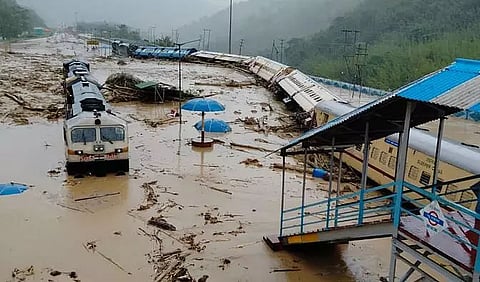
- Home
- Live Blog
- Breaking News
- Top Headlines
- Cities
- NE News
- Sentinel Media
- Sports
- Education
- Jobs

Nearly 70% of embankments in Assam have outlived their span which explains the devastation following a recurrence of breaches in every wave of flood in the state in recent years. Strengthening and repair of these embankments involve enormous expenditure which makes it a Herculean task for the state with limited resources. Climate extremes like excessive rains have added to the vulnerability of the embankments and flood intensity which call for an innovative response. The occurrence of 16 breaches in embankments in seven districts on a single day on May 16 due to heavy downpour and strong current and resulting in flash floods in hundreds of villages speaks volumes about the vulnerability of embankments in the state. It is also an ominous sign of the flood situation worsening in the coming days and subsequent waves this year and calls for full preparedness for rescue, relief and rehabilitation work. The current response of piecemeal solution of plugging the breaches in the embankment fails to work as 90% of the total embankment length of 4474 km is in dilapidated condition and breaches may occur in any new segment when the Brahmaputra and Barak and their tributaries are in full spate during the monsoon as well pre-monsoon periods. Official data reveal a mismatch between the approved cost of flood management work and actual funds released by the Central Government, the latter falling short of than requirements. Institutional weakness in the timely and judicious utilization of funds is among the key factors behind such a mismatch. A radical change in the overall situation cannot be expected without rectification of such institutional weakness and rigorous monitoring and roping in experts to provide innovative solutions. Besides, long-term and permanent solutions will continue to be elusive till flood management is taken up for the entire Brahmaputra and Barak basin. The Central Government's stated position is that flood management primarily falls under the purview of state governments and it only supplements such efforts by providing technical guidance and promotional financial assistance in critical areas. Assam Integrated River Basin Management Project (AIRBMP) being implemented with the assistance of the World Bank has triggered hopes of the state partially overcoming the challenge of availability of funds for flood and erosion management. Assam Cabinet cleared the decks for the implementation of AIRBMP in February and approved phase I of the project worth 83 million US dollars. The AIRBMP has five project components– Institutional Strengthening, Integrated River Basin Planning and Demonstrative Investments, Flood and Erosion Management, Project Management and Contingency Emergency Response Component. The Department of Economic Affairs, Government of India has granted in-principle approval to the project. The project is being implemented by the Special Purpose Vehicle-Flood & River Erosion Management Agency of Assam (FREMAA). Under phase, I of the project two comprehensive flood management schemes at Buridehing river and Manas Beki river are to be implemented at a total cost of Rs 1393 crore. Results from these projects will depend on the pace and quality of project work which can be ensured through regular and rigorous inspection, monitoring and evaluation. Lessons must be learnt from cost and time overruns in most flood management projects which deprive the targeted beneficiaries of the desired benefits and leave them at the mercy of vagaries of nature for long years. The economic cost of such delay is huge, and it pushes flood and erosion affected households into a poverty trap. Diversion of the state's resources for poverty alleviation programmes for these people leads to curtailing of funds for development projects including health and education and that is why fast-tracking flood management projects are crucial to improving the state's resources for infrastructure and other development projects. Implementation of AIRBMP projects is going to take time and till protection measures are strengthened, improving rescue, relief and rehabilitation are critical to providing temporary relief to flood and erosion-hit families. There is a provision for releasing additional funds from the National Disaster Response Fund to states in case of a disaster of severe nature in case a state government exhausts funds placed at its disposal under the State Response Fund. There is no dearth of funds for relief works and states like Assam taking timely stock of disaster preparedness and improving the response mechanism need to be prioritized. Building community resilience through the adoption of flood-resistant crop varieties, high-yielding varieties, cooperative farming, and augmenting household income to absorb economic and financial shocks caused by flood damage to crops, dwelling houses and displacement due to erosion. Meticulous and innovative planning of using the space in makeshift relief camps can facilitate the continuation of education for children in affected areas. This has become even more crucial to ensure that the learning loss due to the COVID-19 pandemic on account of lack of access to the internet in vast areas of rural Assam is not extended because of a long stay in relief camps in multiple waves of the flood. The state needs an innovative disaster response.